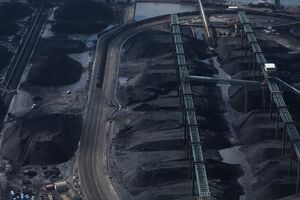Wet Dust Suppression: Difference between revisions
No edit summary |
added notes from covering the train cars page |
||
| Line 1: | Line 1: | ||
Loading and unloading coal out of the railcar, most commonly via bottom dump out the railcar base or via rollover wagon tipplers, displaces a lot of air and therefore kicks up a lot of [[Particulate matter and coal dust|coal dust]]. One proposed solution is to suppress the dust before the coal exiting the loading hoppers. This suppression (usually by water or chemical spray) would ideally occur within the railcar wagon to prevent the exit of the dust during the loading process.<ref>[https://nodust.com/application/rail-loading-unloading/ “Rail Loading & Unloading.” ''Dust Solutions Inc.'', 7 Aug. 2023, nodust.com/application/rail-loading-unloading/.]</ref> | |||
== Water Suppression == | == Water Suppression == | ||
[[File:Dominion Terminal Water Application.jpg|alt=Dominion Terminal Water Application|thumb|While the sprinklers are not on at the moment of the photograph, large amounts of standing water are visible at the Dominion Terminal.]] | [[File:Dominion Terminal Water Application.jpg|alt=Dominion Terminal Water Application|thumb|While the sprinklers are not on at the moment of the photograph, large amounts of standing water are visible at the Dominion Terminal.]] | ||
| Line 10: | Line 12: | ||
== Chemical Coatings == | == Chemical Coatings == | ||
Many private companies offer chemical sprays that coat the coal, usually within the train car, with a sealant that prevents fugitive dust emissions. | |||
== Documents == | == Documents == | ||
Revision as of 04:07, 10 June 2025
Loading and unloading coal out of the railcar, most commonly via bottom dump out the railcar base or via rollover wagon tipplers, displaces a lot of air and therefore kicks up a lot of coal dust. One proposed solution is to suppress the dust before the coal exiting the loading hoppers. This suppression (usually by water or chemical spray) would ideally occur within the railcar wagon to prevent the exit of the dust during the loading process.[1]
Water Suppression

Coal dust emissions in Southeast Newport News and Lambert's Point are primarily managed using wet suppression methods that consist of spraying water, or water with chemical additives, over coal storage piles, railcars, and/or transloading equipment using a system of sprinklers. Water application is often adjusted based on terminal activity and ambient humidity conditions.
Water suppression is mentioned in the record as early as the 1920s, when the Chesapeake and Ohio (C&O) Railroad Company installed a custom pipe system to spray water on coal-filled railcars where and when the cars were emptied through overturning.[2] Following an air monitoring study in 1956 demonstrating coal was a major portion of airborne dust in Southeast Newport News and pressure from the Newport news City Council, C&O installed equipment to create a water fog over the coal piers to suppress dust.[3]
Today, the coal export terminals continue to rely on water suppression despite community calls for other forms of dust mitigation, particularly a wind fence or dome in Southeast Newport News or railcar coverings in Lambert's Point. The Kinder Morgan Bulk Terminals use a system of 44 sprinklers to spray water that suppresses dust emissions from the piles and transloading equipment.
Water suppression is argued to be effective at fairly low cost,[4] and the terminals in Southeast Newport News and Lambert's Point have fought against other dust mitigation methods because of their associated costs.[5] Despite decades of dust control using water suppression, nearby residents continue to report evidence that coal dust affects local air quality, outside and in their homes.
Chemical Coatings
Many private companies offer chemical sprays that coat the coal, usually within the train car, with a sealant that prevents fugitive dust emissions.
Documents
- Railroads of Port Adopt Coal Sprinkle: Growing demand for Sprinkled Coal Said to Be Made by Trans-Shippers, Daily Press, November 23, 1927
- Ohio Office of Air Pollution Control, Reasonably Available Control Measures for Fugitive Dust Sources (Part 1), September 1980
- Ohio Office of Air Pollution Control, Reasonably Available Control Measures for Fugitive Dust Sources (Part 2), September 1980
- Ohio Office of Air Pollution Control, Reasonably Available Control Measures for Fugitive Dust Sources (Part 3), September 1980
- Ohio Office of Air Pollution Control, Reasonably Available Control Measures for Fugitive Dust Sources (Part 4), September 1980
- Email Correspondence between Richard Posner of Dust Solutions, Inc. and Repair Lab Team Member, 2023
References
- ↑ “Rail Loading & Unloading.” Dust Solutions Inc., 7 Aug. 2023, nodust.com/application/rail-loading-unloading/.
- ↑ Railroads of Port Adopt Coal Sprinkle: Growing demand for Sprinkled Coal Said to Be Made by Trans-Shippers, Daily Press, November 23, 1927.
- ↑ C&O to Install Costly Equipment for Control of Air Pollution in NN, Daily Press, December 12, 1956.
- ↑ Ohio Office of Air Pollution Control, Reasonably Available Control Measures for Fugitive Dust Sources (Part 2), September 1980.
- ↑ Email Correspondence with Richard Posner, President of Dust Solutions Inc., 2023.